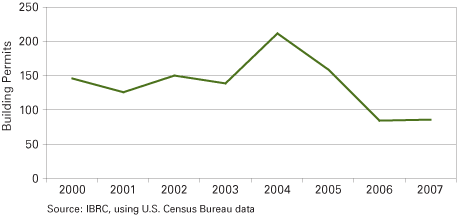Richmond Forecast 2009
President, Lingle Real Estate
November 2008
Although not as active as in the past, the Wayne County housing market has not had the dramatic drop in values that has occurred in other parts of the country, such as California, Florida, and Nevada.
The average sale price for single-family homes in Wayne County reported by the Richmond Management Listing Service peaked at $103,000 in 2005 and has dropped in 2008 by a little over 10 percent from that 2005 high. This compares with 20 percent to 40 percent decreases in other areas of the country. Of course, we didn't have the tremendous appreciation that occurred, so there was not as far to fall. When you compare today's average sale price with 2003, Wayne County's price is down approximately 5 percent.
The annual 20 percent appreciation (and sometimes more) of homes was greatly responsible for the collapse of the real estate market nationally and internationally. People would buy more expensive homes or refinance their current home and spend the money. When the market turned, due to overbuilding and a softer economy, some homes were worth less than the loan balance. Because Wayne County did not have that kind of run-up in prices (3 percent in a year was a big increase for us), we have had a much softer landing. Moreover, Wayne County did not experience the overbuilding of new single-family homes that occurred in many areas, so there were fewer new homes to be absorbed.
The number of single-family Wayne County homes that were listed by the Richmond Management Listing Service peaked in 2005 at 1,800. As of October 1, 2008, the number of homes placed on the market stood at 1,354. Because the average number of days on the market is higher and people are more tuned into housing, the perception is that a lot more homes are on the market than normal.
Although foreclosures are higher than in past years, they are a fraction of what they are in other areas of the country. It is impossible to get an accurate number due to the process. Troubled mortgage loans are often negotiated with lenders who will adjust the loan balance owed—resulting in a short sale—or take title to the homes rather than actually foreclosing.
As of November 7, 2008, 734 single-family homes were sold in the past twelve months in Wayne County according to the Richmond Listing Service. This figure only includes homes sold by the real estate community and not those homes transferred without the services of a real estate agent.
Meanwhile, the number of building permits in Wayne County has decreased, down 41 percent since the turn of the century (see Figure 1).
Figure 1: Wayne County Building Permits, 2000 to 2007

With the recent troubles in the stock market, a lot of investors like the tangible control that they enjoy with real estate. Typically, these are properties that have loan delinquency and are in need of some minor reconditioning. The net income generated by the property can often produce a 15 percent or higher return. And, of course, there is the opportunity for rather substantial price appreciation in the future.
Outlook for 2009
What about the future? As is often the case, the future can be seen by looking into the past. In 1981, when mortgage rates were 16.5 percent, short-term interest rates were 21 percent, and inflation was 12 percent, housing was at a much bigger standstill in Wayne County than it is today. There was little, if any, financing available and a 16.5 percent borrowing rate was not very desirable. Today, although the credit markets are much more selective than in the recent past, money is available to qualified buyers at very reasonable interest rates. Thirty-year fixed-rate loans have been consistently available in the 6 percent interest rate range.
Wayne County housing is and will be affected a lot more by the local economic issues. Employment and new job creation has and will continue to be vital for a healthy housing market, but also for healthy retail, service, and government sectors.
Also in this Issue…
- Outlook for 2009
- International Outlook for 2009
- U.S. Outlook for 2009
- Financial Outlook for 2009
- Housing Market Outlook for 2009
- Indiana's Outlook for 2009
- Indiana's Agricultural Outlook for 2009
- Indiana's Special Sectors Outlook for 2009
- Anderson Forecast 2009
- Bloomington Forecast 2009
- Columbus Forecast 2009
- Evansville Forecast 2009
- Fort Wayne Forecast 2009
- Gary Forecast 2009
- Indianapolis-Carmel Forecast 2009
- Kokomo Forecast 2009
- Louisville Forecast 2009
- Muncie Forecast 2009
- Richmond Forecast 2009
- South Bend and Elkhart Area Forecast 2009
- Terre Haute Forecast 2009
- Return to Table of Contents



